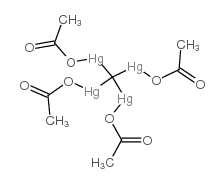25201-30-3
| Name | acetyloxy-[tris(acetyloxymercurio)methyl]mercury |
|---|---|
| Synonyms | tamm |
| Melting Point | 255-275ºC (dec.) |
|---|---|
| Molecular Formula | C9H12Hg4O8 |
| Molecular Weight | 1050.55000 |
| Exact Mass | 1055.94000 |
| PSA | 105.20000 |
| LogP | 0.26000 |
|
Section 1: Product Identification Chemical Name:Tetrakis(acetoxymercuri)methane, min. 95% CAS Registry Number:25201-30-3 Formula:C(HgOOCCH3)4 EINECS Number:none Chemical Family:organomercury compound Synonym:Carbon tetra(acetoxymercuride)
Section 2: Composition and Information on Ingredients IngredientCAS NumberPercentACGIH (TWA)OSHA (PEL) Title Compound25201-30-3100%0.01mg/m3 (Hg)1mg/10m3 (Hg) Section 3: Hazards Identification Toxic by inhalation, in contact with skin and if swallowed. Danger of cumulative effects. Prolonged exposure Emergency Overview: may permanently degrade the central nervous system. Primary Routes of Exposure:Ingestion, skin, Inhalation of dust. Eye Contact:May cause mild to severe irritation of the eyes. May deposit mercury in the lens of the eye. Skin Contact:May cause mild to severe irritation of the skin. May be absorbed through the skin. Dust may cause severe respiratory and gastrointestinal distress, and may damage the central nervous Inhalation: system. Ingestion:May cause lack of appetite, abdominal cramps, vomiting, kidney failure and paralysis. Poison. Stomach upset and pain, mouth pain, vomiting, excessive salivation, urine production stops, urine Acute Health Affects: products appear in the blood, ataxia (difficulty in moving). The chronic effects of mercury poisoning include stomatitis, tremors, psychic disturbances, excessive Chronic Health Affects:salivation, dermatitis, and pain on chewing. Other effects include loss of memory, insomnia, lack of confidence, irritability and depression, speech and gait impairment. NTP:No IARC:No OSHA:No SECTION 4: First Aid Measures Immediately flush the eyes with copious amounts of water for at least 10-15 minutes. A victim may need Eye Exposure: assistance in keeping their eye lids open. Get immediate medical attention. Wash the affected area with water. Remove contaminated clothes if necessary. Seek medical assistance if Skin Exposure: irritation persists. Remove the victim to fresh air. Closely monitor the victim for signs of respiratory problems, such as difficulty Inhalation: in breathing, coughing, wheezing, or pain. In such cases seek immediate medical assistance. Seek medical attention immediately. Keep the victim calm. Give the victim water (only if conscious). Induce Ingestion: vomiting only if directed by medical personnel. SECTION 5: Fire Fighting Measures Flash Point:not applicable Autoignition Temperature:no data Explosion Limits:no data Extinguishing Medium:dry chemical, carbon dioxide, water, or foam. Fire fighters should be equipped with a NIOSH approved positive pressure self-contained breathing apparatus Special Fire Fighting Procedures: and full protective clothing. Hazardous Combustion andIf involved in a fire this material may emit toxic mercury fumes and carbon monoxide. Decomposion Products: Unusual Fire or Explosion Hazards: No unusual fire or explosion hazards. SECTION 6: Accidental Release Measures Small spills can be mixed with vermiculite, sodium carbonate or other suitable non combustible adsorbent and Spill and Leak Procedures: swept up. SECTION 7: Handling and Storage Handling and Storage:Store solid in a tightly sealed container in a cool dry place. SECTION 8: Exposure Controls and Personal Protection Eye Protection:Always wear approved safety glasses when handling a chemical substance in the laboratory. Skin Protection:Wear protective clothing and gloves. Consult with glove manufacturer to determine the proper type of glove. Ventilation:Material may form a toxic fine dust. If possible, handle the material in an efficient fume hood. If in form of fine dust and ventilation is not available a respirator should be worn. The use of respirators Respirator: requires a Respirator Protection Program to be in compliance with 29 CFR 1910.134. Ventilation:Material may form a toxic fine dust. If possible, handle the material in an efficient fume hood. Additional Protection:No additional protection required. SECTION 9: Physical and Chemical Properties Color and Form:white xtl. Molecular Weight:1050.55 Melting Point:255-275° dec. Boiling Point:no data Vapor Pressure:no data Specific Gravity:no data Odor:none Solubility in Water:insoluble SECTION 10: Stability and Reactivity Stability:air and moisture stable Hazardous Polymerization:no hazardous polymerization Conditions to Avoid:none Incompatibility:azides, fulminates and reducing agents Decomposition Products:carbon dioxide, carbon monoxide, organic fumes, and toxic mercury fumes. SECTION 11: Toxicological Information RTECS Data:No information available in the RTECS files. Carcinogenic Effects:no information available Mutagenic Effects:no information available Tetratogenic Effects:no information available SECTION 12: Ecological Information Avoid release to the environment. Very toxic to aquatic organisms. May cause long-term adverse effects in the Ecological Information: aquatic environment. SECTION 13: Disposal Considerations Disposal:Dispose of according to federal, state, and local regulations. SECTION 14: Transportation Shipping Name (CFR):Mercury compounds, solid, N.O.S. Hazard Class (CFR):6.1 Additional Hazard Class (CFR):NA Packaging Group (CFR):II UN ID Number (CFR):UN# 2025 Shipping Name (IATA):Mercury compound, solid, N.O.S. Hazard Class (IATA):6.1 Additional Hazard Class (IATA):NA Packaging Group (IATA):II UN ID Number (IATA):UN# 2025 SECTION 15: Regulatory Information TSCA:Not listed in the TSCA inventory. SARA (Title 313):Title compound: See Category Code N458 for reporting. Second Ingredient:none SECTION 16 - ADDITIONAL INFORMATION N/A |
| Risk Phrases | R33;R26/27/28 |
|---|---|
| Safety Phrases | S13-S28-S45 |
